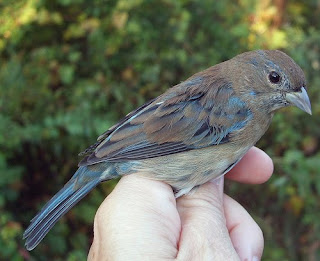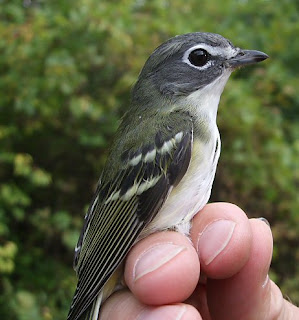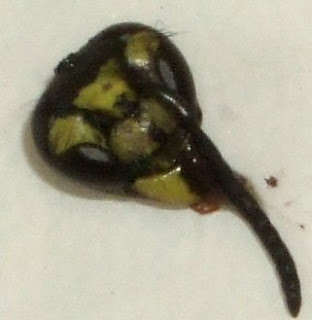On 13 September 2010, this Veery (
Catharus fuscescens)
was banded by the Rouge River Bird Observatory. It was so
different-looking that the species identification was not readily
apparent when it was pulled from the net. The bird was a young
(hatching-year) bird based on plumage characteristics and, conclusively,
a largely unossified skull .
The upperparts of the thrush were a rich, medium brown (the lack of a contrasting, rufous rump and tail, plus measurements and other plumage characteristics, eliminated Hermit Thrush,
Catharus guttatus).
The grayish face without an eye ring quickly ruled out Swainson’s Thrush (
Catharus ustulatus,but had me briefly considering Gray-cheeked Thrush (
Catharus minimus),
and some measurements between this species and Veery overlap. The sixth
primary feather of Gray-cheeked Thrushes, however, is usually
emarginated, while in Veery this feather is only slightly emarginated, as was the case with this bird. Nearly all measurements were a little too large for this bird to be a Bicknell’s Thrush (
Catharus bicknelli). Neither of these two species is noted to have plumage with this warm coloration.
This left Veery. The color of the RRBO bird was not the bright,
nearly orange, color that is typical of most eastern Veeries seen here
in southeast Michigan, seen at right. This is the nominate subspecies,
C. fuscescens fuscescens. See, for example,
this photo from New Jersey.
There are up to six subspecies of Veery, although they are often combined into three groups. One is the nominate eastern
C. fuscescens fuscescens which breeds in much of eastern Canada, through New England, south through much of the Appalachians. Another is the western
C. fuscescens salicicolus,
sometimes called the Willow Thrush. References describe the upperparts
as being “dull, dark brown with a warm rufescent-olive tinge” , “dull, moderately dark brown with a reddish tinge” , and “slightly more olive-brown and on upperparts and only faintly tinged rufous comparied to nominate” .
While descriptions also indicated that has more distinct spots than
the nominate race, the rich reddish color of the upperparts, without olive and evident even in the shade, did not seem to fit this western race.
 Catharus fuscescens fuliginosus
Catharus fuscescens fuliginosus, or “Newfoundland Veery,” is
a subspecies that nests in southwest Newfoundland, Magdalen Island and
south-central Quebec, perhaps into northern Maine and southern Nova
Scotia. The upperparts are described as “deep reddish brown,” “deep
bright reddish brown,” and “slightly deeper or warm reddish-brown …than
either nominate or
salicicolus.” References also note the spots
on this race are more distinct, with Clement (2000) specifying “sharply
defined reddish-brown, arrowhead-shaped spots (larger than on nominate)
extensively across breast.” The distinctness and shape of the spots is especially
evident in the RRBO in the photo at left.
Our bird, then, seems to fit the description of a “Newfoundland
Veery.” Some breeding populations in the southern Appalachians
(considered by some as
C. fuscescens pulichorum) also have upperparts similar to
fuliginosus, as do some other western and Great Plains subspecies often lumped with
salicicolus, but overall more plumage characteristics of the RRBO bird seem to coincide with
fuliginosus
than other races. Most authors note that there is variability among
individuals and some that appear to be “intermediate forms” so we can’t
be 100% sure of the provenance of this bird, only that the plumage
corresponds to the Newfoundland race.
Finally, we can’t rule out a hybrid. Kent McFarland of the
Vermont Center for Ecosystem Studies and member of the
International Bicknell’s Thrush Conservation Group
told me he had once banded a Bicknell’s x Veery hybrid. Very
intriguing, but not possible to determine without a feather or tissue
sample, and someone able to do DNA work.
Veery is the least-common of the
Catharus thrushes banded at RRBO, and it was a real treat to catch this one.
Martin Reid has
an interesting page of Catharus thrushes, including some variations on Veeries.
 You can take a look at some of the other birds we have recaptured years after their original banding on this page at the RRBO site. Note that on that page, the "age" indicated is the period that has elapsed between captures, not a calculated age.
You can take a look at some of the other birds we have recaptured years after their original banding on this page at the RRBO site. Note that on that page, the "age" indicated is the period that has elapsed between captures, not a calculated age.
























